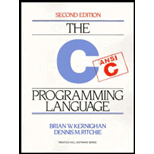
Run the “hello, world”
To run the hello world program and experiment with leaving out parts of the hello world program, to see the error message.
Explanation of Solution
Program:
//Leaving out header file
//#include <stdio.h>
main()
{
printf("Hello, ");
printf("World");
printf("\n");
}
Explanation:
The program above leaving the header file <stdio.h> statement to see the error. There is a warning in the program and shows the output.
Sample Output:

Program:
#include <stdio.h>
//Leaving out main function
//main()
{
printf("Hello, ");
printf("World");
printf("\n");
}
Explanation:
The program above leaving the main function to see the error. There is an error in program line 4.
Sample Output:

Program:
#include <stdio.h>
main()
{
//Leaving out first statement line
//printf("Hello, ");
printf("World");
printf("\n");
}
Explanation:
The program above leaving the first statement line to see the error. There is no error and print world, then a new line.
Sample Output:

Program:
#include <stdio.h>
main()
{
printf("Hello, ");
//Leaving out second statement line
//printf("World");
printf("\n");
}
Explanation:
The program above leaving the second statement line to see the error. There is no error and print hello, then a new line.
Sample Output:

Program:
#include <stdio.h>
main()
{
printf("Hello, ");
printf("World");
//Leaving out third statement line
//printf("\n");
}
Explanation:
The program above leaving the third statement line to see the error. There is no error and print hello,world without a new line.
Sample Output:

Program:
#include <stdio.h>
//Leaving out curley braces.
main()
//{
printf("Hello, ");
printf("World");
printf("\n");
//}
Explanation:
On leaving the curly braces the program will not compile and produce compilation error.
Sample Output:

Want to see more full solutions like this?
Chapter 1 Solutions
C Programming Language
Additional Engineering Textbook Solutions
Elementary Surveying: An Introduction To Geomatics (15th Edition)
SURVEY OF OPERATING SYSTEMS
Concepts Of Programming Languages
Java: An Introduction to Problem Solving and Programming (8th Edition)
Starting Out with Python (4th Edition)
Mechanics of Materials (10th Edition)
- show all the workarrow_forwardList down the strenghts and weaknesses of your team project for Capsim Simulation? Explan.arrow_forwardCapsim Team PowerPoint Presentations - Slide Title: Key LearningsWhat were the key learnings that you discovered as a team through your Capsim simulation?arrow_forward
- Write the SQL code that permits to implement the tables: Student and Transcript. NB: Add the constraints on the attributes – keys and other.arrow_forwardDraw an ERD that will involve the entity types: Professor, Student, Department and Course. Be sure to add relationship types, key attributes, attributes and multiplicity on the ERD.arrow_forwardDraw an ERD that represents a book in a library system. Be sure to add relationship types, key attributes, attributes and multiplicity on the ERD.arrow_forward
- 2:21 m Ο 21% AlmaNet WE ARE HIRING Experienced Freshers Salesforce Platform Developer APPLY NOW SEND YOUR CV: Email: hr.almanet@gmail.com Contact: +91 6264643660 Visit: www.almanet.in Locations: India, USA, UK, Vietnam (Remote & Hybrid Options Available)arrow_forwardProvide a detailed explanation of the architecture on the diagramarrow_forwardhello please explain the architecture in the diagram below. thanks youarrow_forward
 C++ Programming: From Problem Analysis to Program...Computer ScienceISBN:9781337102087Author:D. S. MalikPublisher:Cengage Learning
C++ Programming: From Problem Analysis to Program...Computer ScienceISBN:9781337102087Author:D. S. MalikPublisher:Cengage Learning C++ for Engineers and ScientistsComputer ScienceISBN:9781133187844Author:Bronson, Gary J.Publisher:Course Technology Ptr
C++ for Engineers and ScientistsComputer ScienceISBN:9781133187844Author:Bronson, Gary J.Publisher:Course Technology Ptr A+ Guide to Hardware (Standalone Book) (MindTap C...Computer ScienceISBN:9781305266452Author:Jean AndrewsPublisher:Cengage Learning
A+ Guide to Hardware (Standalone Book) (MindTap C...Computer ScienceISBN:9781305266452Author:Jean AndrewsPublisher:Cengage Learning- Programming Logic & Design ComprehensiveComputer ScienceISBN:9781337669405Author:FARRELLPublisher:CengageNp Ms Office 365/Excel 2016 I NtermedComputer ScienceISBN:9781337508841Author:CareyPublisher:Cengage
 Microsoft Visual C#Computer ScienceISBN:9781337102100Author:Joyce, Farrell.Publisher:Cengage Learning,
Microsoft Visual C#Computer ScienceISBN:9781337102100Author:Joyce, Farrell.Publisher:Cengage Learning,





